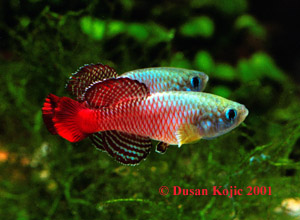|
Genus Nothobranchius |
 |
Nothobranchius palmqvisti
| It is one of most colorful genera of the family Cyprinodontidae, inhabiting in waters of subtropical and tropical parts of east and southeast of Africa. They are small fish, reaching average length of about 5-6 cm. The fins and coloration in the males are always more gorgeous than in the females. In contrast, the females are all a gray color. Areas inhabited by the
Nothobranchius contain water during the rainy season, and they dry out quickly afterwards. They live through the dry period as embryos inside hard eggs, hatching only at the beginning of the next rainy season. Then they grow quickly and lay eggs after only a few weeks or months. The live and frozen foods are recommended and flakes are usually not accepted. They are zealous eaters, but do not overfeed. It is necessary to clean uneaten food, especially if it is frozen. They breed in annual manner. Eggs are deposited in the surface of peat. Being fish breeder during long period I have some experience with protozoan disease Oodinium, which often affects Nothobranchius. The fry are especially prone to this parasitic disease. Gray-white or yellow dust like dots appear on an infested fish's skin and fins. It is easy to cure with various remedies in other fishes, but Nothos are often sensitive on such treatment especially on remedies containing copper or zinc. It is much better to prevent disease than cure it. Many killifish breeders use small tank without filtration for raising of fry. In case that you do not make partial water changes and keep the water clean, it is almost certain that your Notho fry will be affected with Oodinium. Overstocking and over feeding, will also multiply risk of contamination. Usual first food for Notho fry is newly hatched Artemia. Be sure to feed just as much as fry can eat, because uneaten Artemia will spoil the water. Adding of sponge filter and salt (1tbs per 10 lit. of water) is recommended. It helps to maintain the proper water quality and enable Artemia to live longer in the tank. If you do everything as described you will stave off this disease that is especially dangerous for fry. However, in case that Oodinium affects your fish it is best to use prolonged Acriflavine or zinc-free Malachite green baths. Mr. Jiri Vitek recommends in his book Halancici* a following procedure: 1. Make partial water change (50%) 2. Add 2 or 3 tbs. of salt per 10 liter of water 3. Add Acriflavine or Malachite green in standard concentration 4. Next weeks make partial water change (50-70%) and add remedies 5. Repeat until the fish are cured. Mr. Vitek also recommends short baths: " Dissolve 6-8 teaspoons of salt into 1 litter of water. Then put a fish into this solution for 3 - 6 min. If it stops moving with a mouth before this time (an osmotic shock), take it out immediately. This procedure is a little rough but very effective. You can see the brown parasites falling from a skin of a fish. It is useful only for bigger fishes, in most cases for adults, not for youngsters. The procedure may be repeated after few days, but very often one procedure is sufficient. Sometimes it happens that a fish does not survive this procedure." However, the best way to have healthy fish is prevention, so try to avoid the disease. * Jiri Vitek & Jaroslav Kadlec - Halancici (Killifish) published: CZKC (1988) |
[home][gallery][fish & egg list][emailme]
All photos copyright by © Dusan Kojic 2001